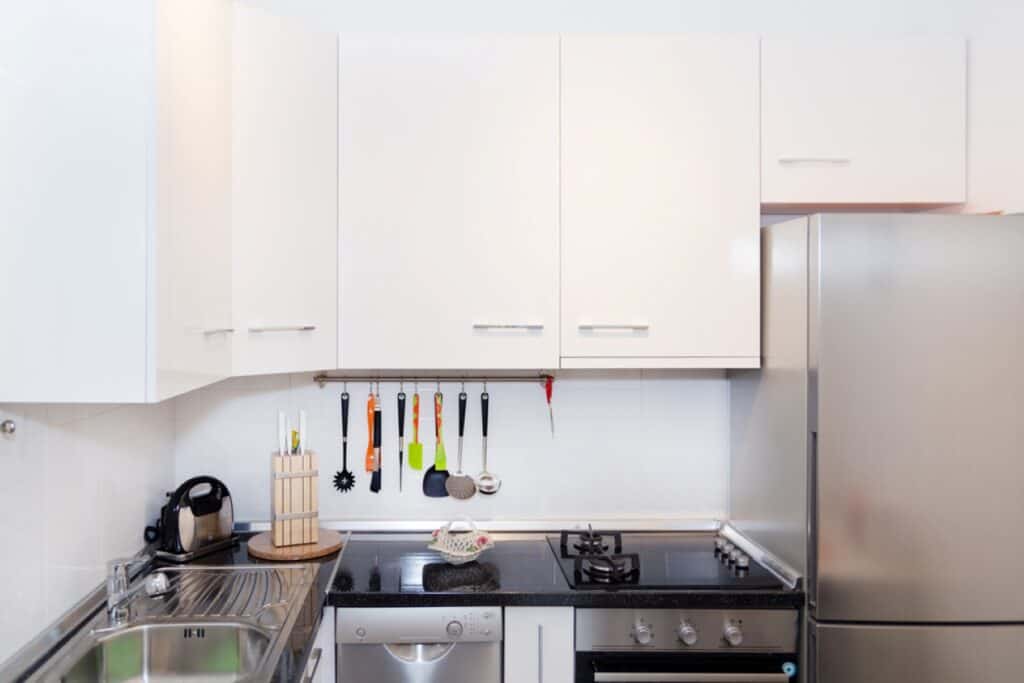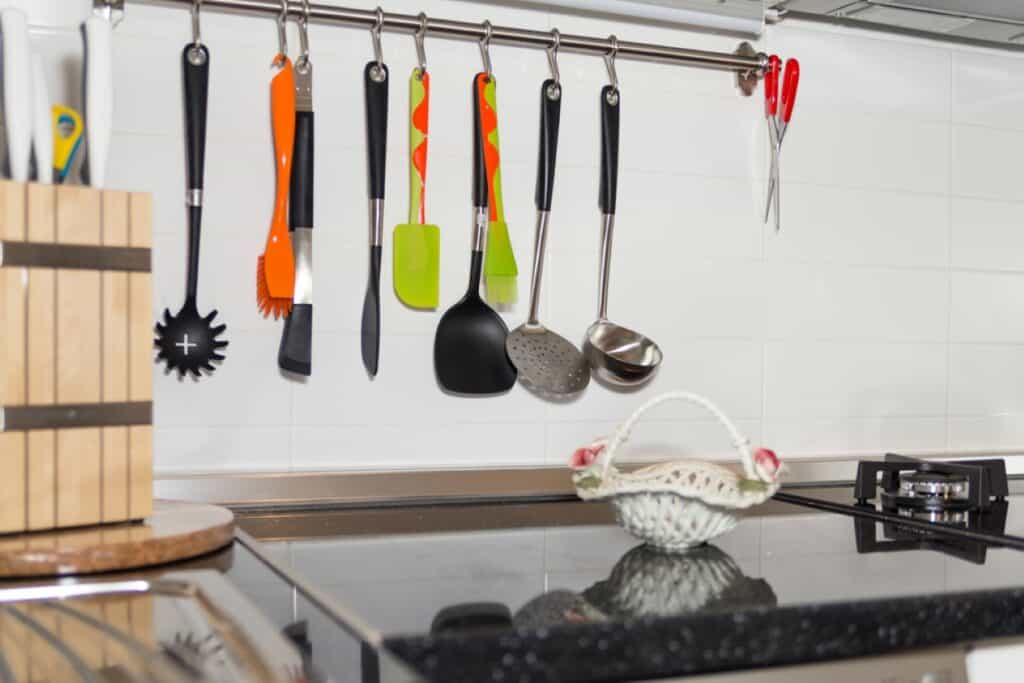Figuring out how to organize a small kitchen is all about smart planning to transform a tight space into a spacious, inviting one. By decluttering and adopting savvy storage solutions, you can make the most of your kitchen, making it simpler to move around and more enjoyable for cooking.

Innovative strategies can transform small kitchens by visually enlarging the space, enhancing functionality and boosting style without requiring additional square footage. Creative use of vertical space, along with selecting the right storage solutions and furniture, can turn your kitchen into an efficient and inviting area to unlock the full potential of your small kitchen.
Maximizing vertical space
In small kitchens, vertical space is often underutilized. Making the most of the room’s height can free up valuable square footage.
Using wall and cabinet doors
Walls and cabinet doors are often underutilized spaces that can significantly boost your kitchen’s storage capability. By fitting hooks and racks inside cabinet doors, you create the perfect spots for hanging utensils, measuring cups and small pots, keeping them tidy and out of the way.
Moreover, installing wall-mounted spice racks, knife strips and utensil holders keeps your countertops clear and ensures your cooking essentials are within easy reach. Lisa Wells of Cook Eat Well shares a valuable tip, “My favorite space-saving hack is to mount a spice rack on the inside of a kitchen cabinet door. This keeps your spices organized and within reach, especially if you hang the rack in a cabinet next to the stove or prep area.” This method is particularly effective for recipes requiring a variety of spices, like a sweet and spicy turkey chili recipe. By integrating hooks for mugs and utensils, racks for lids and baking sheets and magnetic strips for knives and spice racks, you maximize your kitchen’s vertical storage and simplify the cooking process by having everything you need at your fingertips.
Stackable shelving and hanging items

Stackable shelves not only effectively double the storage capacity of cabinets by creating additional levels for dishes and food containers but also introduce a new dimension of organization. Jessica Haggard of Easy Homemade Life shares, “Transforming my small kitchen with stackable shelving and ceiling-mounted racks was a game-changer. I no longer had to juggle pots and pans on overcrowded countertops; instead, I freed up valuable surface area for meal prep and cooking.” This sentiment echoes the benefits of utilizing every inch of vertical space. Hanging baskets beneath shelves are ideal for storing produce, like potatoes for recipes such as twice baked potato casserole, and ceiling-mounted pot racks significantly free up cabinet space.
Moreover, retractable features like pull-down shelves further enhance the usability of high spaces. Whether it’s stackable wire shelves for cabinets, under-shelf baskets for miscellaneous items or pull-down racks for higher cabinets, these hanging and stackable options are crucial for maximizing storage efficiency in small kitchens.
Efficient storage solutions
Optimizing space in a small kitchen hinges on selecting the right storage solutions. These methods should maximize every inch of available space while maintaining accessibility and order.
Drawer organizers

Drawer organizers are a practical way to keep utensils and tools tidy. Measure drawers before purchasing organizers to ensure a perfect fit. Consider adjustable dividers for flexibility and modular trays to keep flatware, knives and other cooking tools neatly separated.
- Measurements: Ensure you measure your drawers’ height, width and depth.
- Materials: Look for durable materials like bamboo or metal that can be easily cleaned.
- Design: Opt for organizers with non-slip bases to prevent shifting while opening and closing drawers.
Transparent containers
Using transparent containers is a smart way to easily see what’s inside, which saves time and reduces clutter. These containers can be neatly stacked, maximizing vertical space in the kitchen. Adding labels to these containers brings an additional level of organization, making it simpler to find what you need quickly.
Space-saving furniture
Furniture that doubles as storage maximizes space in a small kitchen. Look for multipurpose pieces like a fold-down table that can be a prep area, an island with drawers or a dining spot with storage underneath.
- Multifunctional tables: Tables with storage can serve as additional countertop space and a place to stow items.
- Seating with storage: Opt for benches or stools that open up to hold infrequently used appliances or bulk items.
- Moveable islands: A rolling island can be a workstation, a serving cart or storage and can easily be moved as needed.
Decluttering and organizing
Decluttering and organizing a small kitchen starts with sorting items to maximize space and utilizing the pantry efficiently.
Sorting kitchen items
First, categorize your kitchen items into three groups: frequently used, seldom used and rarely or never used.
- Frequently used items: These should be easily accessible. Utilize the prime real estate areas of your kitchen, such as the lower shelves for plates, bowls and everyday glasses.
- Seldom-used items: Consider higher shelves or out-of-the-way storage areas for items like specialty cooking devices and fancy dishware.
- Rarely used items: These may be candidates for donation or storage outside the kitchen.
Consider creating an inventory list to track where items are stored. Doing this can help maintain order and prevent clutter accumulation.
Utilizing the pantry
In a small kitchen pantry, making the most of every inch is essential for efficiency and ease of use. Organizing items by type and frequency of use will significantly streamline your cooking process. For instance, using clear, airtight containers to store pantry staples such as canned goods, pasta, rice and cereals saves precious space and extends the freshness of these ingredients. This organization strategy shines when making dishes that require a variety of pantry items, like this easy tuna noodle casserole. Labeling these containers and positioning them with labels facing outward ensures quick access to what you need, making meal prep a breeze even in the most compact of spaces.
Adding shelving solutions, such as tiered shelves, improves access to items at the back of the pantry just as easily as those at the front. Under-shelf baskets introduce additional layers of storage, maximizing space. Adopting a first-in, first-out system helps use older items before newer ones, minimizing waste and efficiently utilizing pantry space.
Maintaining kitchen order
Learning how to organize a small kitchen involves finding the perfect balance between functionality and cleanliness. To enhance your kitchen’s functionality, keep frequently used items within easy reach and store less used appliances in higher or deeper cabinets.
Maintaining a regular cleaning routine in a small kitchen is key to avoiding clutter, as even a little mess can quickly overwhelm the space. Using straightforward strategies like timing your cleaning sessions or rewarding yourself afterward can help keep the area tidy and ensure the routine sticks.
Sara Nelson is the creator of Real Balanced, a food blog that showcases easy and balanced recipes. Since 2017, she has shared these recipes with thousands of blog readers and social media followers. Sara lives in Wisconsin with her family.